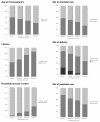Inequalities in maternity care and newborn outcomes: one-year surveillance of births in vulnerable slum communities in Mumbai
- PMID: 19497130
- PMCID: PMC2701945
- DOI: 10.1186/1475-9276-8-21
Inequalities in maternity care and newborn outcomes: one-year surveillance of births in vulnerable slum communities in Mumbai
Abstract
Background: Aggregate urban health statistics mask inequalities. We described maternity care in vulnerable slum communities in Mumbai, and examined differences in care and outcomes between more and less deprived groups.
Methods: We collected information through a birth surveillance system covering a population of over 280 000 in 48 vulnerable slum localities. Resident women identified births in their own localities and mothers and families were interviewed at 6 weeks after delivery. We analysed data on 5687 births over one year to September 2006. Socioeconomic status was classified using quartiles of standardized asset scores.
Results: Women in higher socioeconomic quartile groups were less likely to have married and conceived in their teens (Odds ratio 0.74, 95% confidence interval 0.69-0.79, and 0.82, 0.78-0.87, respectively). There was a socioeconomic gradient away from public sector maternity care with increasing socioeconomic status (0.75, 0.70-0.79 for antenatal care and 0.66, 0.61-0.71 for institutional delivery). Women in the least poor group were five times less likely to deliver at home (0.17, 0.10-0.27) as women in the poorest group and about four times less likely to deliver in the public sector (0.27, 0.21-0.35). Rising socioeconomic status was associated with a lower prevalence of low birth weight (0.91, 0.85-0.97). Stillbirth rates did not vary, but neonatal mortality rates fell non-significantly as socioeconomic status increased (0.88, 0.71-1.08).
Conclusion: Analyses of this type have usually been applied across the population spectrum from richest to poorest, and we were struck by the regularly stepped picture of inequalities within the urban poor, a group that might inadvertently be considered relatively homogeneous. The poorest slum residents are more dependent upon public sector health care, but the regular progression towards the private sector raises questions about its quality and regulation. It also underlines the need for healthcare provision strategies to take account of both sectors.
Figures
Similar articles
-
Examining inequalities in uptake of maternal health care and choice of provider in underserved urban areas of Mumbai, India: a mixed methods study.BMC Pregnancy Childbirth. 2015 Sep 28;15:231. doi: 10.1186/s12884-015-0661-6. BMC Pregnancy Childbirth. 2015. PMID: 26416081 Free PMC article.
-
Stillbirths and newborn deaths in slum settlements in Mumbai, India: a prospective verbal autopsy study.BMC Pregnancy Childbirth. 2012 May 30;12:39. doi: 10.1186/1471-2393-12-39. BMC Pregnancy Childbirth. 2012. PMID: 22646304 Free PMC article. Clinical Trial.
-
Tracing pathways from antenatal to delivery care for women in Mumbai, India: cross-sectional study of maternity in low-income areas.Int Health. 2009 Sep;1(1):71-7. doi: 10.1016/j.inhe.2009.02.004. Int Health. 2009. PMID: 20119484 Free PMC article.
-
Prospective study of determinants and costs of home births in Mumbai slums.BMC Pregnancy Childbirth. 2010 Jul 30;10:38. doi: 10.1186/1471-2393-10-38. BMC Pregnancy Childbirth. 2010. PMID: 20670456 Free PMC article.
-
Institutional delivery in public and private sectors in South Asia: a comparative analysis of prospective data from four demographic surveillance sites.BMC Pregnancy Childbirth. 2016 Sep 20;16:273. doi: 10.1186/s12884-016-1069-7. BMC Pregnancy Childbirth. 2016. PMID: 27649897 Free PMC article.
Cited by
-
Examining inequalities in uptake of maternal health care and choice of provider in underserved urban areas of Mumbai, India: a mixed methods study.BMC Pregnancy Childbirth. 2015 Sep 28;15:231. doi: 10.1186/s12884-015-0661-6. BMC Pregnancy Childbirth. 2015. PMID: 26416081 Free PMC article.
-
Healthcare choices in Mumbai slums: A cross-sectional study.Wellcome Open Res. 2017 Dec 5;2:115. doi: 10.12688/wellcomeopenres.13127.2. eCollection 2017. Wellcome Open Res. 2017. PMID: 30027122 Free PMC article.
-
Out-of-pocket expenditure and its predictors for illness of under-five children: A cross-sectional study in urban slums of Eastern India.J Family Med Prim Care. 2021 Oct;10(10):3892-3898. doi: 10.4103/jfmpc.jfmpc_2337_20. Epub 2021 Nov 5. J Family Med Prim Care. 2021. PMID: 34934698 Free PMC article.
-
Community resource centres to improve the health of women and children in Mumbai slums: study protocol for a cluster randomized controlled trial.Trials. 2013 May 8;14:132. doi: 10.1186/1745-6215-14-132. Trials. 2013. PMID: 23782816 Free PMC article. Clinical Trial.
-
Stillbirths and newborn deaths in slum settlements in Mumbai, India: a prospective verbal autopsy study.BMC Pregnancy Childbirth. 2012 May 30;12:39. doi: 10.1186/1471-2393-12-39. BMC Pregnancy Childbirth. 2012. PMID: 22646304 Free PMC article. Clinical Trial.
References
-
- United Nations . World urbanization prospects: the 2003 revision. New York: United Nations; 2004. http://esa.un.org/unup/
-
- United Nations Human Settlements Programme (UN-Habitat) The challenge of slums: global report on human settlements 2003. London and Sterling VA: Earthscan Publications Ltd; 2003.
-
- Caldwell J, Caldwell B. Poverty and mortality in the context of economic growth and urbanization. Asia-Pacific Popul J. 2002;17:49–66.
Grants and funding
LinkOut - more resources
Full Text Sources




